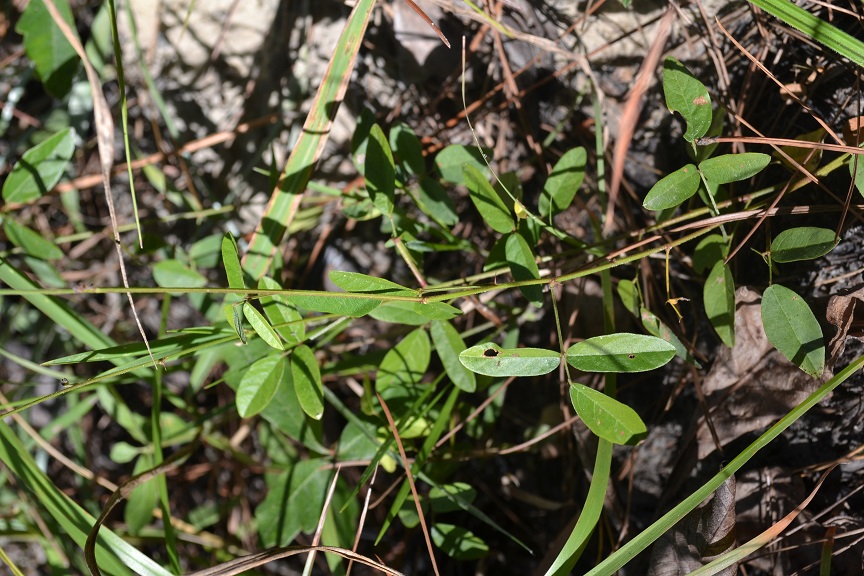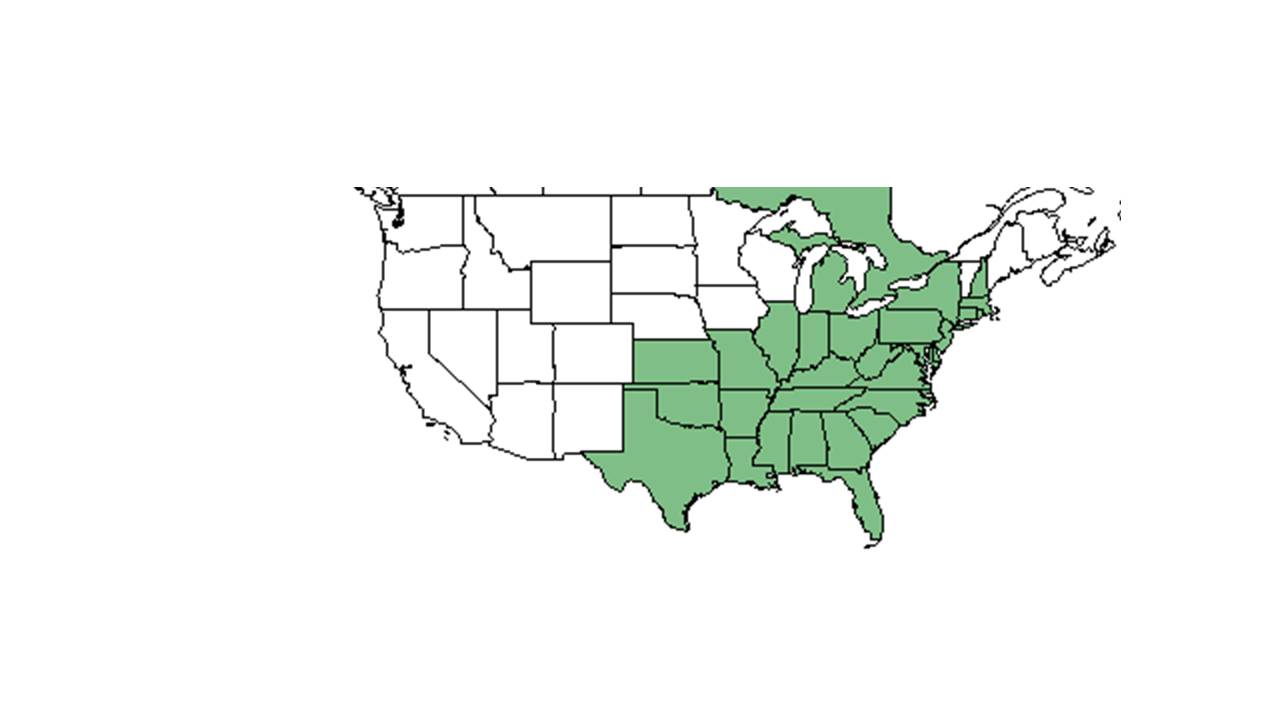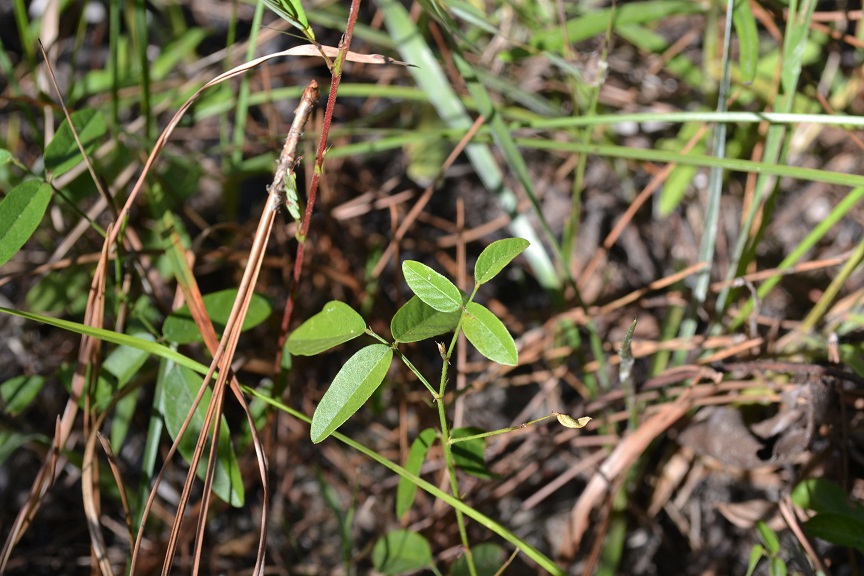Difference between revisions of "Desmodium marilandicum"
| Line 37: | Line 37: | ||
Generally, this species can be found in woodland borders, fields, and disturbed areas.<ref name= "Weakley"/> Habitats that ''D. marilandicum'' has been observed in include pine-oak-hickory woodlands, open, upland pine, dry ridges, and sandhills. Can occur in disturbed areas such as woodlands bordering the road, clearing in a live-oak woodland, clearing between pineland and field, edge of mixed woods around a campground, sterile hillside, and abandoned fields. Requires semi-shaded to open areas. Grows in loamy sand and clayey soil types.<ref name=fsu>Florida State University Robert K. Godfrey Herbarium database. URL: http://herbarium.bio.fsu.edu. Last accessed: June 2014. Collectors: Loran C. Anderson, R. K. Godfrey, V. Sullivan, J. Wooten, A. F. Clewell, R. Kral, R. Komarek, T. MacClendon, - Boothes; K. Blum, Norlan C. Henderson, John W. Thieret, H. R. Reed, Delzie Demaree, A. C. Mathews, A. E. Radford, G. W. Parmelee, and H. A. Wahl. States and Counties: Alabama: Cleburne, Franklin, and Russell. Arkansas: Drew. Florida: Jackson and Leon. Georgia: Baker and Decatur. Indiana: Elkhart. Louisiana: Morehouse and Natchitoches. Michigan: Barry. Mississippi: Pearl River. Missouri: Henry. North Carolina: Orange and Surry. Pennsylvania: Venango. Virginia: Montgomery.</ref> | Generally, this species can be found in woodland borders, fields, and disturbed areas.<ref name= "Weakley"/> Habitats that ''D. marilandicum'' has been observed in include pine-oak-hickory woodlands, open, upland pine, dry ridges, and sandhills. Can occur in disturbed areas such as woodlands bordering the road, clearing in a live-oak woodland, clearing between pineland and field, edge of mixed woods around a campground, sterile hillside, and abandoned fields. Requires semi-shaded to open areas. Grows in loamy sand and clayey soil types.<ref name=fsu>Florida State University Robert K. Godfrey Herbarium database. URL: http://herbarium.bio.fsu.edu. Last accessed: June 2014. Collectors: Loran C. Anderson, R. K. Godfrey, V. Sullivan, J. Wooten, A. F. Clewell, R. Kral, R. Komarek, T. MacClendon, - Boothes; K. Blum, Norlan C. Henderson, John W. Thieret, H. R. Reed, Delzie Demaree, A. C. Mathews, A. E. Radford, G. W. Parmelee, and H. A. Wahl. States and Counties: Alabama: Cleburne, Franklin, and Russell. Arkansas: Drew. Florida: Jackson and Leon. Georgia: Baker and Decatur. Indiana: Elkhart. Louisiana: Morehouse and Natchitoches. Michigan: Barry. Mississippi: Pearl River. Missouri: Henry. North Carolina: Orange and Surry. Pennsylvania: Venango. Virginia: Montgomery.</ref> | ||
| − | ''D. marilandicum'' was found to increase in occurrence in response to soil disturbance by agriculture in | + | ''D. marilandicum'' was found to increase in occurrence in response to soil disturbance by agriculture in South Carolina coastal plain habitat. It has shown regrowth in reestablished longleaf pineland that was disturbed by agriculture, making it a post-agricultural woodlands indicator species.<ref>Brudvig, L.A. and E.I. Damchen. (2011). Land-use history, historical connectivity, and land management interact to determine longleaf pine woodland understory richness and composition. Ecography 34: 257-266.</ref><ref>Brudvig, L.A., E Grman, C.W. Habeck, and J.A. Ledvina. (2013). Strong legacy of agricultural land use on soils and understory plant communities in longleaf pine woodlands. Forest Ecology and Management 310: 944-955.</ref><ref>Brudvig, L.A., J.L. Orrock, E.I. Damschen, C.D. Collins, P.G. Hahn, W.B. Mattingly, J.W. Veldman, and J.L. Walker. (2014). Land-Use History and Contemporary Management Inform an Ecological Reference Model for Longleaf Pine Woodland Understory Plant Communities. PLoS ONE 9(1): e86604.</ref> |
Additionally, it was found to have variable changes in occurrence and abundance to disturbance by clearcutting and chopping in South Carolina. It showed both resistance to regrowth and positive regrowth in areas with reestablished native forest habitat that was disturbed by these practices.<ref>Cushwa, C.T. and M.B. Jones. (1969). Wildlife Food Plants on Chopped Areas in Piedmont South Carolina. Note SE-119. Asheville, NC: U.S. Department of Agriculture, Forest Service, Southeastern Forest Experiment Station. 4 pp.</ref> | Additionally, it was found to have variable changes in occurrence and abundance to disturbance by clearcutting and chopping in South Carolina. It showed both resistance to regrowth and positive regrowth in areas with reestablished native forest habitat that was disturbed by these practices.<ref>Cushwa, C.T. and M.B. Jones. (1969). Wildlife Food Plants on Chopped Areas in Piedmont South Carolina. Note SE-119. Asheville, NC: U.S. Department of Agriculture, Forest Service, Southeastern Forest Experiment Station. 4 pp.</ref> | ||
Revision as of 18:43, 21 June 2021
| Desmodium marilandicum | |
|---|---|

| |
| Photo taken by Kevin Robertson | |
| Scientific classification | |
| Kingdom: | Plantae |
| Division: | Magnoliophyta - Flowering plants |
| Class: | Magnoliopsida – Dicotyledons |
| Order: | Fabales |
| Family: | Fabaceae ⁄ Leguminosae |
| Genus: | Desmodium |
| Species: | D. marilandicum |
| Binomial name | |
| Desmodium marilandicum (L.) DC. | |

| |
| Natural range of Desmodium marilandicum from USDA NRCS Plants Database. | |
Common name: Smooth Small-leaf Tick-trefoil; Maryland Tick-trefoil
Contents
Taxonomic notes
Synonym: Meibomia marilandica (Linnaeus) Kuntze.[1]
Varieties: none.[1]
Description
Generally, for Desmodium genus, they are "annual or perennial herbs, shrubs or small trees. Leaves 1-5 foliolate, pinnately 3-foliolate in ours or rarely the uppermost or lowermost 1-foliolate; leaflets entire, usually stipellate; stipules caduceus to persistent, ovate to subulate, foliaceous to setaceous, often striate. Inflorescence terminal and from the upper axils, paniculate or occasionally racemose; pedicel of each papilionaceous flower subtended by a secondary bract or bractlet, the cluster of 1-few flowers subtended by a primary bract. Calyx slightly to conspicuously 2-lipped, the upper lip scarcely bifid, the lower lip 3-dentate; petals pink, roseate, purple, bluish or white; stamens monadelphous or more commonly diadelphous and then 9 and 1. Legume a stipitate loment, the segments 2-many or rarely solitary, usually flattened and densely uncinated-pubescent, separating into 1-seeded, indehiscent segments." [2]
Specifically, for D. marilandicum species, they are "erect perennial; stems 0.6-1.5 m tall, glabrous or sparsely uncinulate-puberulent and short-pubescent, but never pilose. Terminal leaflets ovate to suborbicular or oblong to elliptic, 1-2.5 (5) cm long, usually 1.6-2.2 as long as wide, both surfaces glabrous to moderately short-pubescent especially on the calyx lobes; petals purplish, 4-6 mm long; stamens diadelphous. Loment of 1-3 weekly obovate segments, each 3.5-5.5 mm long, 3-4 mm broad, slightly convex to almost straight along the upper suture; stipe 1.5-2.5 mm long, equaling or shorter than the calyx and exceeded by the stamina remnants." [2]
Distribution
D. marilandicum is native to the United States from Massachusetts west to Michigan and Missouri and south to Texas and north peninsular Florida.[3] It is also native to Ontario province in Canada.[4]
Ecology
Habitat
Generally, this species can be found in woodland borders, fields, and disturbed areas.[3] Habitats that D. marilandicum has been observed in include pine-oak-hickory woodlands, open, upland pine, dry ridges, and sandhills. Can occur in disturbed areas such as woodlands bordering the road, clearing in a live-oak woodland, clearing between pineland and field, edge of mixed woods around a campground, sterile hillside, and abandoned fields. Requires semi-shaded to open areas. Grows in loamy sand and clayey soil types.[5]
D. marilandicum was found to increase in occurrence in response to soil disturbance by agriculture in South Carolina coastal plain habitat. It has shown regrowth in reestablished longleaf pineland that was disturbed by agriculture, making it a post-agricultural woodlands indicator species.[6][7][8]
Additionally, it was found to have variable changes in occurrence and abundance to disturbance by clearcutting and chopping in South Carolina. It showed both resistance to regrowth and positive regrowth in areas with reestablished native forest habitat that was disturbed by these practices.[9]
Associated species: Desmodium strictumm, Pinus palustris, Aristida sp., and others.[5]
Phenology
D. marilandicum flowers from June to September, and fruits from June to September.[3] It has been observed flowering from August through October with peak inflorescence in October; and fruiting from September through November.[5][10] The fruit is dry but does not split open when ripe.[11]
Seed dispersal
This species is thought to be dispersed by translocation on animal fur or feathers. [12]
Fire ecology
It can withstand areas with annual burns and winter burns.[5] Fire seasonality does not seem to affect D. marilandicum much since one study found the species in high frequency after spring and summer burns as well.[13] A study by Lajeunesse in 2006 found that nitrogen and carbon levels significantly increased in D. marilandicum populations in both sandy and clayey sites, where more of a difference was seen in sandy than clayey sites.[14]
Pollination and use by animals
A short tongued bee Calliopsis andreniformis has been observed on Desmodium marilandicum.[15] D. marilandicum is a source of food for white-tailed deer.[16]
Conservation, cultivation, and restoration
D. marilandicum is listed as endangered by the New Hampshire Natural Heritage Inventory, Division of Forests and Lands.[4] For restoration, D. marilandicum can be planted along with other native forb species to restore longleaf pine-wiregrass savanna herbaceous vegetation.[17]
Cultural use
Photo Gallery
References and notes
- ↑ 1.0 1.1 Weakley, A.S. 2015. Flora of the southern and mid-atlantic states. Working Draft of 21 May 2015. University of North Carolina at Chapel Hill, Chapel Hill, North Carolina.
- ↑ 2.0 2.1 Radford, Albert E., Harry E. Ahles, and C. Ritchie Bell. Manual of the Vascular Flora of the Carolinas. 1964, 1968. The University of North Carolina Press. 604-10. Print.
- ↑ 3.0 3.1 3.2 Weakley, A. S. (2015). Flora of the Southern and Mid-Atlantic States. Chapel Hill, NC, University of North Carolina Herbarium.
- ↑ 4.0 4.1 USDA, NRCS. (2016). The PLANTS Database (http://plants.usda.gov, 26 April 2019). National Plant Data Team, Greensboro, NC 27401-4901 USA.
- ↑ 5.0 5.1 5.2 5.3 Florida State University Robert K. Godfrey Herbarium database. URL: http://herbarium.bio.fsu.edu. Last accessed: June 2014. Collectors: Loran C. Anderson, R. K. Godfrey, V. Sullivan, J. Wooten, A. F. Clewell, R. Kral, R. Komarek, T. MacClendon, - Boothes; K. Blum, Norlan C. Henderson, John W. Thieret, H. R. Reed, Delzie Demaree, A. C. Mathews, A. E. Radford, G. W. Parmelee, and H. A. Wahl. States and Counties: Alabama: Cleburne, Franklin, and Russell. Arkansas: Drew. Florida: Jackson and Leon. Georgia: Baker and Decatur. Indiana: Elkhart. Louisiana: Morehouse and Natchitoches. Michigan: Barry. Mississippi: Pearl River. Missouri: Henry. North Carolina: Orange and Surry. Pennsylvania: Venango. Virginia: Montgomery.
- ↑ Brudvig, L.A. and E.I. Damchen. (2011). Land-use history, historical connectivity, and land management interact to determine longleaf pine woodland understory richness and composition. Ecography 34: 257-266.
- ↑ Brudvig, L.A., E Grman, C.W. Habeck, and J.A. Ledvina. (2013). Strong legacy of agricultural land use on soils and understory plant communities in longleaf pine woodlands. Forest Ecology and Management 310: 944-955.
- ↑ Brudvig, L.A., J.L. Orrock, E.I. Damschen, C.D. Collins, P.G. Hahn, W.B. Mattingly, J.W. Veldman, and J.L. Walker. (2014). Land-Use History and Contemporary Management Inform an Ecological Reference Model for Longleaf Pine Woodland Understory Plant Communities. PLoS ONE 9(1): e86604.
- ↑ Cushwa, C.T. and M.B. Jones. (1969). Wildlife Food Plants on Chopped Areas in Piedmont South Carolina. Note SE-119. Asheville, NC: U.S. Department of Agriculture, Forest Service, Southeastern Forest Experiment Station. 4 pp.
- ↑ Nelson, G. PanFlora: Plant data for the eastern United States with emphasis on the Southeastern Coastal Plains, Florida, and the Florida Panhandle. www.gilnelson.com/PanFlora/ Accessed: 26 APR 2019
- ↑ [[1]]Accessed: April 21, 2016
- ↑ Kirkman, L. Katherine. Unpublished database of seed dispersal mode of plants found in Coastal Plain longleaf pine-grasslands of the Jones Ecological Research Center, Georgia.
- ↑ Cushwa, C. T., et al. (1970). Response of legumes to prescribed burns in loblolly pine stands of the South Carolina Piedmont. Asheville, NC, USDA Forest Service, Research Note SE-140: 6.
- ↑ Lajeunesse, S. D., et al. (2006). "Ground layer carbon and nitrogen cycling and legume nitrogen inputs following fire in mixed pine forests." American Journal of Botany 93: 84-93.
- ↑ [[2]]Encyclopedia of Life. Accessed: April 21, 2016
- ↑ Atwood, E. L. (1941). "White-tailed deer foods of the United States." The Journal of Wildlife Management 5(3): 314-332.
- ↑ Aschenbach, T. A., et al. (2010). "The initial phase of a longleaf pine-wiregrass savanna restoration: species establishment and community responses." Restoration Ecology 18(5): 762-771.
